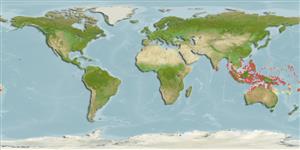Common names from other countries
Environment: milieu / climate zone / depth range / distribution range
Écologie
marin récifal; non migrateur; profondeur 1 - 12 m (Ref. 90102), usually 2 - 3 m (Ref. 9790). Tropical; 19°N - 23°S
Western Pacific: Philippines, Borneo, Moluccas, Papua New Guinea, New Caledonia, Palau, and Yap Island to Ishigaki Island. Range extended to Mentawai Islands (Indonesia).
Taille / Poids / Âge
Maturity: Lm ? range ? - ? cm
Max length : 50.0 cm TL mâle / non sexé; (Ref. 9710); common length : 35.0 cm TL mâle / non sexé; (Ref. 9790)
Épines dorsales (Total) : 9 - 10; Rayons mous dorsaux (Total) : 11; Épines anales: 0; Rayons mous anaux: 11. Small juveniles all black, gradually changing to the blotched pattern of the adult (Ref. 48635). Rear edge of maxilla ends well in front of eye. Prominent pit present behind upper eye. Preopercular spines short, usually 2, subequal. Infraorbital ridge usually smooth over eye. Suborbital ridge largely smooth, bearing 2 spines below eye. Oblique scale rows slanting backward above lateral line more or less equals number of lateral-line scales. Dermal papillae (10-12 in adults) on upper eye, some simple, some branched, longest not reaching supraorbital ridge. Interopercular flap usually broader than long, with several subdivisions.
Lives on sand or rubble substrates of sheltered or semi-exposed reefs to a depth of at least 8 m (Ref. 9710). Well camouflaged on reefs (Ref. 48635). Also found in coral reefs and mangrove area in about 1-12 m (Ref 90102).
Life cycle and mating behavior
Maturities | Reproduction | Spawnings | Egg(s) | Fecundities | Larves
Myers, R.F., 1991. Micronesian reef fishes. Second Ed. Coral Graphics, Barrigada, Guam. 298 p. (Ref. 1602)
Statut dans la liste rouge de l'IUCN (Ref. 130435)
CITES (Ref. 128078)
Not Evaluated
Menace pour l'homme
Harmless
Utilisations par l'homme
Pêcheries: pêcheries vivrières
Outils
Articles particuliers
Télécharger en XML
Sources Internet
Estimates based on models
Preferred temperature (Ref.
115969): 27.8 - 29.3, mean 28.8 (based on 1532 cells).
Phylogenetic diversity index (Ref.
82804): PD
50 = 0.5625 [Uniqueness, from 0.5 = low to 2.0 = high].
Bayesian length-weight: a=0.00575 (0.00330 - 0.01002), b=3.08 (2.92 - 3.24), in cm Total Length, based on LWR estimates for this species & (Sub)family-body (Ref.
93245).
Niveau trophique (Ref.
69278): 4.5 ±0.0 se; based on diet studies.
Résilience (Ref.
120179): Milieu, temps minimum de doublement de population : 1,4 à 4,4 années (Preliminary K or Fecundity.).
Fishing Vulnerability (Ref.
59153): Moderate vulnerability (40 of 100).
